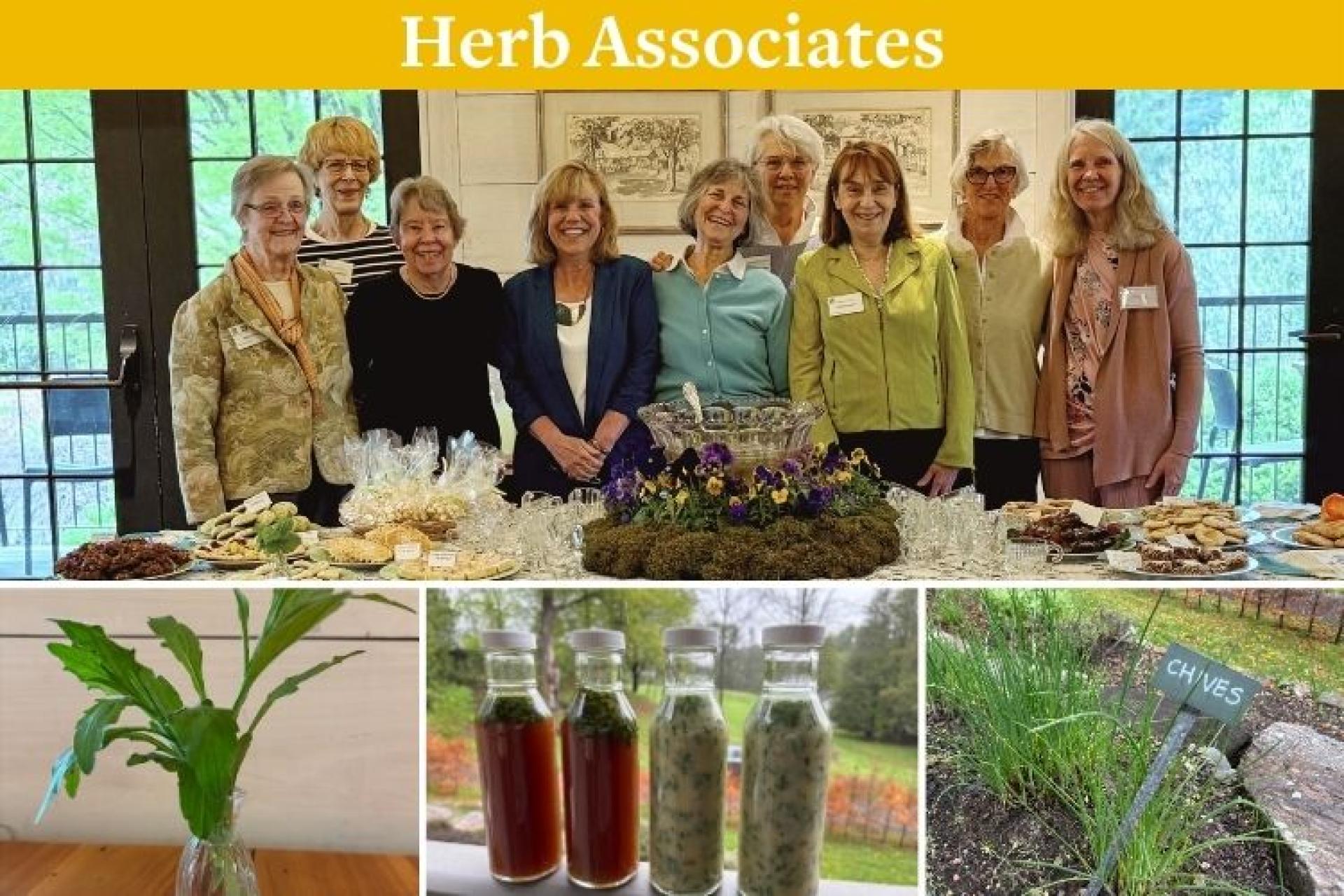You are here
What Is Happening in the Herb Garden and Kitchen?
What Is Happening in the Herb Garden and Kitchen?
By Barbara F. Smith
It’s great to be back in the Herb Gardens at BBG! For decades, the Herb Associates — a volunteer group of devoted gardeners and kitchen wizards who delight in all things herbal — have planted, tended and harvested herbs in the Herb Display and Production Gardens near the Center House. Those herbs are dried, cooked, blended, or preserved in the kitchen there, and the products are sold in the Visitor Center’s Gift Shop to benefit the Garden.
As with longstanding tradition, the Herb Associates welcomed the opening of the Garden season at this year’s Spring Fest, serving the Mai Bowle — a sparkling wine punch flavored with woodruff blossoms, all within a festive display featuring violas and pansies. In addition, visitors enjoyed delicious herb-flavored cookies served from vintage plates festooned with daffodils, painted and donated by members of the Berkshire Garden Club and the Lenox Garden Club nearly 40 years ago (see photos above).
The work of the growing season has begun. Among the earliest (and easiest) perennial herbs to grow are chives (Allium schoenoprasum), and the Production Garden has a bounty. The name of these popular herbs derives from a Latin word meaning onion. The plants grow in tufts to a height of about one foot, with leaves that are hollow and thin. Globe-shaped, edible flowers grow with white blossoms that may have a blue or purple tint.
Hardy to Zone 5, chives prefer sunny conditions, keep a neat appearance and are rarely bothered by pests. Chives can be repeatedly harvested from spring through frost, preferably on a dry day — using scissors or a knife, cutting to within an inch or two of the ground. Once the plant is established it needs little attention beyond weeding. Chives may be planted next to roses to repel aphids (and possibly Japanese beetles and black spot); likewise, chives may repel aphids near celery, lettuce, and peas.
This popular culinary herb can be used in many ways: added to salad dressings or dips, as a garnish in soups, pancakes or omelets; blended with butter and served with grilled meats or fish; and infused in vinegar, particularly the chive blossoms, to name a few suggestions. As one author put it, “the combination of chives from the Old World and potatoes from the New World was truly inspired” (“The Culinary Herbal,” by S. Belsinger and AO Tucker).
Trivia fact of the day: The City of Chicago owes its name to the Native American word sikaakwa (likely Algonquian) meaning a place that smells of wild onions and garlic.
The Herb Associates Kitchen Crew took advantage of the bounty of chives to prepare Lemon Chives Vinaigrette and a Chive Stir-Fry Sauce (shown in the pictures, awaiting labels).
In the course of harvesting the chives, a Herb Associate identified and weeded out several Fleabane plants from the Production Garden (shown in a vase, above). While fleabane (Erigeron genus of the family Asteraceae) was named the “weed of the month” several years ago by the Brooklyn Botanical Garden, it is a worthwhile flowering herb to cultivate. There are more than two hundred species found worldwide, in both annual and perennial varieties. Fleabane is seeing renewed popularity as it is often used in meadow plantings or other naturalized areas.
Fleabane is a common North American native wildflower found in fields or meadows and along roadsides. It prefers full sun, is drought tolerant and is adaptable to many growing conditions. Its deep roots help prevent soil erosion and improve soil structure. Growing 1 to 3 feet tall, fleabane is not invasive, but it can vigorously self-sow. Thankfully, it is easy to control through mowing or pulling. Its small, daisy-like blossoms bloom from spring until autumn. The blossoms attract pollinators, crab spiders and the lynx flower moth. Its seeds are a favorite of goldfinches and sparrows.
Like other “banes” (wolfsbane, dogbane) folklore has it that fleabane plants can ward off pests. There are old stories of people using the stems in animal bedding or even hanging them in bedrooms of homes to keep bugs away. Beyond pest deterrence, fleabane has a history of medicinal purposes used in treating headaches, digestive and respiratory ailments, and wounds.
Join us in the following weeks as we track the growth in the Display and Production Herb Gardens, share information about the history and cultivation of the plants, and get inspired by the Kitchen Crew to try new products.
Happy gardening!
Help Our Garden Grow!
Your donation helps us to educate and inspire visitors of all ages on the art and science of gardening and the preservation of our environment.
All donations are 100 percent tax deductible.


